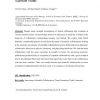Free Online Productivity Tools
i2Speak
i2Symbol
i2OCR
iTex2Img
iWeb2Print
iWeb2Shot
i2Type
iPdf2Split
iPdf2Merge
i2Bopomofo
i2Arabic
i2Style
i2Image
i2PDF
iLatex2Rtf
Sci2ools
SCIENTOMETRICS
2016
2016
The first cut is the deepest: repeated interactions of coauthorship and academic productivity in Nobel laureate teams
: Despite much in-depth investigation of factors influencing this evolution in various scientific fields, our knowledge about how efficiency or creativity is linked to the longevity of collaborative relationships remains very limited. We explore what Nobel laureates’ coauthorship patterns reveal about the nature of scientific collaborations looking at the intensity and success of scientific collaborations across fields and across laureates’ collaborative lifecycles in physics, chemistry, and physiology/medicine. We find that more collaboration with the same researcher is actually no better for advancing creativity: publications produced early in a sequence of repeated collaborations with a given coauthor tend to be published better and cited more than papers that come later in the collaboration with the same coauthor. Thus, our results indicate that scientific collaboration involves conceptual complementarities that may erode over a sequence of repeated interactions. JEL classifica...
| Added | 09 Apr 2016 |
| Updated | 09 Apr 2016 |
| Type | Journal |
| Year | 2016 |
| Where | SCIENTOMETRICS |
| Authors | Ho Fai Chan, Ali Sina Önder, Benno Torgler |
Comments (0)

